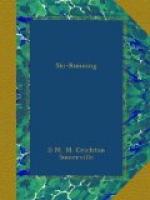In some districts, such as the Bernese Oberland, the Ordnance map has been used for the local Ski tour map, and the tours shown on it in red. This is a great saving of weight and money for the runner, who then only has one map to carry.
Most Ski maps show dangerous avalanche slopes. The local Summer map published in most tourist centres in Switzerland is not much use to the Ski runner, because it shows walks which may be along slopes or down cliffs, which are perfectly safe in Summer and very dangerous in Winter.
I strongly advise all beginners who are bitten by the joy of Ski-ing to buy, at any rate, the small local sheet of the Ordnance Map which usually only costs Frs. 1.30, or roughly 1s., and to study it carefully, noticing the contour lines on the well-known Nursery slopes, and gradually realizing the gradient represented by the different widths between them.
Let him also notice the difference between a hill and a hole on the map. This is easily recognized either by the thin blue line of a stream emerging from a lake, or by comparing the nearest heights shown on the dotted lines or some marked point. Contours are often puzzling to a beginner in map reading, but knowledge of what they represent may save a party from a weary climb back up a place they have gaily ski-ed down, thinking they could get through but finding an impossible slope or fall of rock which forced them to retrace their steps.
Before going on tour even with a Guide, it is wise to study the map with a view to knowing where an Alpine hut can be found in case of need, or where a hay chalet could offer shelter.
When once the Ski runner has begun to appreciate the fun and interest of running by a map, he will never leave it behind, and he will be able to enjoy all sorts of runs he would never know of if he were content with the sheep habit of “following tracks.”
The greatest fun of Ski-ing is in finding one’s own way, and this one can never hope to do without a map.
The following scale of comparative heights in metres and feet may be of use in estimating the heights of points which the Ski runner wishes to reach:
10 metres equal 33 feet (approximately). 50 " " 164 " 100 " " 328 " 250 " " 820 " 500 " " 1,640 " 1,000 " " 3,281 " 2,000 " " 6,562 " 3,000 " " 9,843 "
A compass is, of course, useful when running by map, but as precipices are apt to get in the way when running straight for any given point, a compass cannot be trusted alone. In the case of fog, it is very difficult to avoid difficulties, and points on the map can only be identified by the use of an aneroid, as well as a compass. Set the aneroid at the point you start from and check your heights by this as you climb or descend, referring constantly to the map to ensure that you are running on the right line. It is wise to practise this on clear days in order to get accustomed to running by map, compass and aneroid. As the weather also affects the aneroid, it should be constantly reset at known levels.




